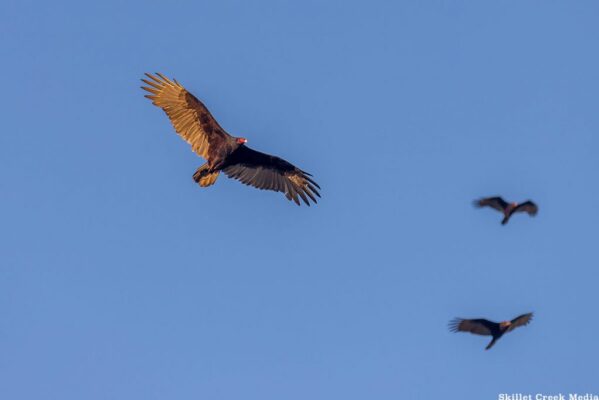No folks, we are NOT taking about the human “door knockers” (aka Storm Chasers) who seem to “swoop” into our area a few days after a weather event, wanting to give you a “free roof damage inspection;” or those who say they will “handle everything “ to get you a “free” new roof from your insurance company.
We are talking about the BIRDS (commonly called VULTURES or BUZZARDS) who many of us will see along the roadside, “lunching on roadkill” !
The United States Department of Agriculture, has published a recent article were “VULTURES/BUZZARDS” (depending on where you grew up) have been known to actually “eat asphalt roof shingles” and cause other damage by “clawing and scratching” roof shingles. If your roof shingles or your car have ever been “bombed” by these large birds (or in our area likely Canada geese) then you may have experienced the strong odor of their feces, the unsightly appearance of their “poop,” and the expensive repair costs they create.
Ideally, it is preferable to “discourage” these feathered creatures from wanting to be around your property. Some effective solutions to make your home “less desirable” may be:
• Keep your home and surrounding acreage as clean as possible to avoid creating a hospitable environment for the “prey” of these “hunters.” In rural areas or along highways, it seems that vultures are attracted to dead animal carcasses and the afterbirth of farm animals or other wildlife. If you see “roadkill” from a deer, possum, raccoon, or even other birds, notify the responsible municipality of the carcass and ask that it be removed. Another clue that a dead animal is nearly tis to see other Buzzards “circling” the area when they find a deceased wildlife that may be attracting the birds.
• Hang a realistic vulture”dummy” from the backside of your roof or from the limb of a nearby tree; so it is not visible from your neighbors across the street. (Yes, you can “Google Vulture dummy or effigy and order your very own.) If the birds believe the dead vulture dummy is real, they may assume the area is unsafe for them and they may pass your property seeking a better “eating opportunity.”
• There are many “bird perch deterrent devices” that can be erected to discourage the birds from choosing your roof for their “hangout.” Some folks stretch a piece of wire or fishing line tightly across their roof, 6 to 8 inches above the area where the birds perch. This can be a lot of trouble and you must stretch the line tightly enough that the birds are unable to push it down and perch on top of it. Also, this type of deterrent must be high enough that the vultures can’t straddle it.
• Noise makers used around dusk (when the birds are getting ready to roost for the night) can act as a deterrent. A barking dog, yelling or clapping your hands loudly to try to disturb or frighten the vultures may be effective. Firecrackers and shotgun blasts can be used to more strongly encourage the birds’ departure, but check with your local authorities first to make sure that you are not violating any local laws. You might want to warn your neighbors of your intentions as well.
• Here is a possible issue with how you choose to address this issue: Vultures are protected under the federal Migratory Bird Treaty Act of 1918. This means that you may not use any lethal means of control without first trying other methods; and then acquiring legal permission to terminate nuisance birds. Kinda like the herding Sheep dogs that are hired for work around busy airports who have a Canada Geese problem which can lead to an aircraft having a “birdstrike.” Permits may also be required to trap and relocate the birds or disturb their nests.

